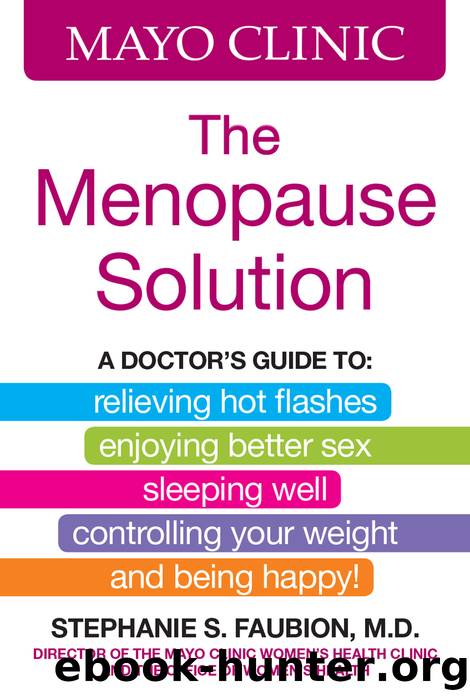Mayo Clinic the Menopause Solution by Stephanie S. Faubion

Author:Stephanie S. Faubion [Stephanie S. Faubion]
Language: eng
Format: epub
Tags: HEA000000
Publisher: Oxmoor House
Published: 2016-04-26T00:00:00+00:00
Alternative options
In addition to standard hormone therapy preparations for menopausal symptoms, other options exist.
TSEC In 2013, the Food and Drug Association (FDA) approved a new type of drug called a tissue-selective estrogen complex (TSEC). This drug pairs a selective estrogen receptor modulator (SERM) with conjugated estrogens. SERMs are estrogen-like compounds but are not hormones per se. As their name implies, they have a selective effect â either blocking or allowing the activity of estrogen in the tissues it acts upon. A number of SERMs are used in the treatment of womenâs health conditions. For example, the drug raloxifene (Evista) is a SERM used to prevent and treat osteoporosis. Tamoxifen (Soltamox) is used to prevent and treat breast cancer, and ospemifene (Osphena) is used to treat pain during intercourse.
In the case of the TSEC drug Duavee, conjugated estrogens provide relief from hot flashes, and the SERM bazedoxifene is used in place of a progestogen. Bazedoxifene has a protective effect on the uterus, similar to progestogens, but it seems to have a neutral effect on the breasts â not causing the increase in density seen with some progestogens. However, its long-term effect on breast cancer risk is unknown. The drug also reduces the risk of fractures and is approved to prevent osteoporosis.
The TSEC treatment is relatively new, and more research is needed to fully understand its benefits and risks and the role it might play in the treatment of menopausal symptoms. In theory, it offers an alternative to progestogens for women who are concerned about the increased health risks that seem to come from adding a progestogen to estrogen therapy. However, keep in mind that not all progestogens are the same, and evidence indicates that progesterone doesnât seem to have the same adverse effects that have been found with synthetic progestins. In addition, the TSEC pairing still contains oral conjugated estrogens, which are associated with an increased risk of stroke and blood clots.
Contraceptives during the menopausal transition
Combination oral contraceptives containing both estrogen and a progestin are a good option for controlling hot flashes in perimenopausal women who still require birth control. They lead to lighter and more-regular periods â which can be a relief if irregular and heavy bleeding is bothersome. They also help preserve bone density, reduce the risk of ovarian and endometrial cancers, reduce painful cramps, and help manage acne. These combination treatments are generally safe for healthy nonsmokers who arenât overweight, and long-term use hasnât been shown to increase the risk of breast cancer. Progestin-only options can be used in women who smoke or have other health complications that prevent use of a pill containing estrogen; however, the progestin-only treatments likely wonât help with hot flashes.
If birth control is your primary goal and you prefer to avoid the hassle of a daily pill, longer term options such as subdermal implants that are inserted just under your skin, a copper IUD or a levonorgestrel- releasing intrauterine system (LNG-IUS) are available. Keep in mind these delivery methods wonât improve your hot flashes.
Download
This site does not store any files on its server. We only index and link to content provided by other sites. Please contact the content providers to delete copyright contents if any and email us, we'll remove relevant links or contents immediately.
| Breast Cancer | Candida |
| Chronic Fatigue Syndrome & Fibromyalgia | Endometriosis |
| General | Lupus |
| Menopause | Menstruation |
| Postpartum Depression | Pregnancy & Childbirth |
| Sexual Health |
Name Book, The: Over 10,000 Names--Their Meanings, Origins, and Spiritual Significance by Astoria Dorothy(2960)
Tone Your Tummy Type by Denise Austin(2811)
The Ultimate Guide to Anal Sex for Women by Tristan Taormino(2267)
The Expectant Father by Armin A. Brott & Jennifer Ash(2243)
The Coregasm Workout by Debby Herbenick(2236)
The Women's Health Fitness Fix by Jen Ator(2220)
Expecting Better by Emily Oster(2186)
She-ology by Sherry A. Ross MD(2144)
The Hite Report on Shere Hite by Shere Hite(2042)
Woman: An Intimate Geography by Natalie Angier(1909)
8 Steps to Reverse Your PCOS by Fiona McCulloch(1890)
Birth by Tina Cassidy(1884)
The Female Brain by M.D. Louann Brizendine(1876)
101 Get-Lean Workouts and Strategies by Muscle & Fitness(1830)
Women & the Weight Loss Tamasha by Diwekar Rujuta(1779)
50 Ways to Soothe Yourself Without Food by Susan Albers(1767)
The Big Booty Blueprint: Your Guide To A Bigger Butt In Less Than 12 Weeks by Bella Rahbek & Brandon Carter(1656)
The overachievers by Robbins Alexandra(1551)
Unleash the Power of the Female Brain: Supercharging Yours for Better Health, Energy, Mood, Focus, and Sex by Daniel G. Amen M.D(1549)
